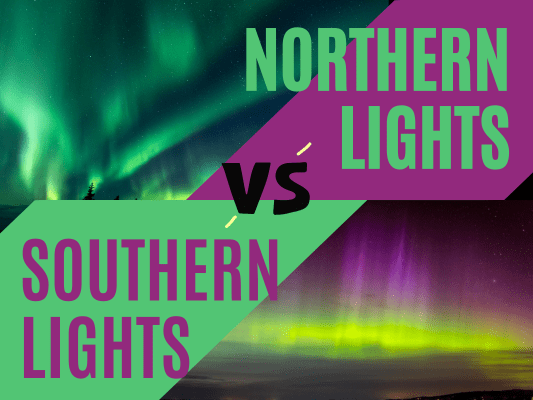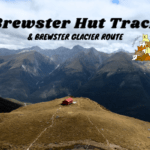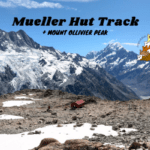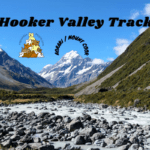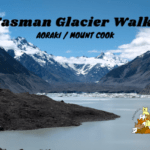Seeing the aurora, the natural lightshow of the universe, is often in the bucket list of travelers all around the world. When people talk about aurora, they usually think about Nordic countries such as the famous aurora watching place, Iceland. However, many are not aware that aurora occurs in the Southern hemisphere too. These Southern lights displays are regularly observed in far South places such as Southern New Zealand, Tasmania, and Patagonia.
Aurora Borealis (Northern Lights) VS Aurora Australis (Southern Lights) - What Are The Differences?
photo licensed via Envato
VS
photo by jasongillman (from Pixabay)
Other than one occurring in the Northern hemisphere and the other in the Southern hemisphere, they also differ in appearances (because of the viewing location, they actually look the same if you see them from the same angle), as you can see in the photos above. Northern lights tend to have those wavy rows of lights (if you are watching almost directly under it, due to the Earth’s tilt angle and your far north location). Southern lights are more commonly seen as a wall of light curtains / pillars due to the angle and distance: eg. Observers in New Zealand are looking at the side angle of the aurora (unless you are in Antarctica, right under the Southern lights, then you would see the wavy rows of lights).
As for the colors, Northern lights tend to be predominantly in green and white, while Southern lights display more colorful hues, predominantly green and pink. This is also due to the angle where the aurora is seen by the observer. The colors are the result of the reactions of different dominant atoms in Earth’s atmosphere when they are hit by solar wind’s electrons. One thing that these auroras share in common, is that Northern and Southern lights activities occur at the same time, as the earth’s north and south magnetic fields are connected together (conditions and level may vary).
In other words, you look up at Northern lights and see it from the bottom, thanks to the land being right under it; In the southern hemisphere, the land is further away from the pole / aurora so you look at the Southern lights ‘across the ocean’.
Best Time To See Aurora
Seasons
Aurora can happen anytime. It does not happen more in the winter than during the summer. The reason winter months are seen as the best time to watch aurora, is due to the longer dark hours. Aurora can happen during the day, but you can’t see it with the sun’s out. In short, the winter months give you more dark hours, increasing the chances of aurora happening during the dark. This doesn’t mean you should stop looking out for aurora in the summer. If you get an aurora alert at night, go for it!
Months
Historically, auroras appeared more in the months of March-April and September-October. Records show that geomagnetic disturbances are more likely in spring and fall then winter and summer. This is due to the Russell-McPherron Effect, where cracks tend to form in Earth’s magnetosphere during weeks around equinoxes (when the Earth’s equator is facing directly to the Sun), allowing solar wind to spark the aurora lights.
Days
Talking about the dark sky, the moonlight is a huge factor on whether you can see the aurora or not. A full moon can easily drown out most lights from the aurora and the galaxies, making moonless nights the favorite night outs for astronomy photographers. However, even on the full moon night, you might still get hours of complete dark sky, since the moon rises and sets at a different time each day.
Hours
The best hours to see the aurora are obviously during the darkest hours. Astronomical twilight is when the sun is gone (below the horizon) but some of its lights are being scattered and bounced back to an observer on the surface. If you take a nighttime photograph during this twilight zone, the photo might show colorful lights, which many people have often mistaken as aurora (it is actually the light from the hidden sun). Thus, the darkest hours (without considering the moon) are after the evening astronomical twilight ends, and before the morning astronomical twilight begins.
Thanks to a passion project, ‘Outside, Looking Up’, developed by Oli Gibbs, we can easily know the exact time of sunset, moonrise, start/end of darkest hours and more useful info in our location, when we plan for our aurora chasing, or even night sky photography trips!
Where To See Southern Lights (Aurora Australis) In New Zealand & Australia
As the Southern lights occur right above the sky of the South pole, you want to be as far South as possible. The Southern region of South Island New Zealand, and the Tasmania and Victoria region of Australia are good locations as they are furthest to the South. While high inland areas are also good, the southern coastal areas such as Stewart Island, The Catlins coast, and even Dunedin city in New Zealand would be the best as there is no light pollution southwards across the ocean.
Here are some recommended aurora viewing locations for 新西兰 和 Australia. Remember to look South!
One of my favorite places to spot aurora near the busy Queenstown is Jack Point’s Beach. You have a far stretch of clearing (thanks to the massive Lake Wakatipu) pointing directly southwards. On a calm, windless night, you might even be able to photograph aurora out of the lake’s reflection!
P.s. The drive to this point can be doggy with huge holes and uneven roads. There is no street light so it’ll be very dark and difficult to find your way at night. It is recommended to first take a recce to this place during the day, so you’ll know how to get here when the aurora is in action.
Can You See Aurora With Your Naked Eyes
During lower level solar storms, the lights from aurora are rather weak to be seen clearly with the naked eyes, unless it is really dark. You are likely to see it with your own eyes during higher level storms in dark skies. Our camera lenses, however, are more sensitive and can pick up these faint lights to show them in the photos. Even during a highly visible aurora event, you most likely can only see faint gray curtains of lights floating in the sky (still an amazing sight to see though!).
I captured this aurora with my phone from Jack Point’s Beach during the mid level active storm. At one point the lights suddenly rammed up its power, I could clearly see the pillars of light shining through the dark sky. It was so amazing!
One thing to keep in mind is don’t give up too fast! The sky was pretty ‘quiet’ in the first hour we were there. We went aurora chasing because we received an alert for possible aurora, but it is usually hard to predict when it will show, or if it will show at all. Thanks to our persistence, we then saw a faint light which signaled the start of the light show!
These were taken from Crown Range Summit car park, I hiked a few hundred meters up the track for a higher, better view over the other mountains. I received a strong storm alert (I saw it late as I was just finishing a long hike after dark) but by the time I packed up and drove here, the power of the aurora had subsided.
Aurora Forecast (Can We Predict It?)
Short answer: YES and NO
Before asking WHEN aurora will occur, we should understand WHY it occurs. Here’s how it happens (simplified): Sometimes, some magnetic fields, created by the electrical currents of charged gas in the Sun, push their way up to the Sun’s surface. When the magnetic field stretches outwards and twists like a rubberband, it breaks off and shoots a powerful wave of electrically charged gas (plasma) away from the Sun, this is called the Solar Storm or Coronal Mass Ejections (CMEs).
If the solar storm is hurling directly towards Earth, it usually takes somewhere between 15 hours (for a very strong one) to typically 2-4 days to hit our planet. Fortunately, Earth has its own magnetic field that shields and deflects the solar storm, protecting us from these cosmic radiation. Since Earth’s magnetic fields start and end in the North and South pole, when the Sun’s magnetic fields from the solar storm join the Earth magnetic fields, they create a funnel where the gasses from the solar storm stream along the magnetic lines towards the poles. These charged electrons excite the atoms in the atmosphere above the poles, creating beautiful colored light displays: The Aurora.
So…
YES, Aurora Can Be Predicted, To Some Extent
When a magnetic field with the plasma surfaces the Sun, coronal holes (sunspots) can be observed by specialized telescopes. Scientists will also know when the Sun has thrown a Coronal Mass Ejection (CME) or High Speed Stream (HSS) of Solar Wind towards Earth.
But also…
NO, Aurora Cannot Be Forecasted Effectively
CMEs happen spontaneously, and we cannot predict these solar activities. Since it takes around 2-4 days for the storm to reach the Earth after the ejection occurs, that would be the furthest time ahead we could predict aurora. However, it does not guarantee an aurora display, due to many variations of the reactions between the solar wind and Earth’s magnetic fields. The storm may be a direct hit to Earth (even that doesn’t guarantee an aurora), a sideswipe (might create weak aurora), or a complete miss (no aurora). Speed and density of the solar wind, Interplanetary Magnetic Field, Hemispheric Power are some other factors that determine the occurrence of aurora, which we’re not gonna touch in this post, but it shows the level of uncertainty to predict aurora.
So yeah, you can’t be asking “Will there be an aurora on my vacation in New Zealand next couple weeks?” Nope nopey nope.
OK, Now We Have An Aurora. What About The Weather?
Just like any other astronomical event, aurora chasers dread cloudy skies when the show is on. The rule of thumb is: If you can’t see the stars, you can’t see the aurora lights. Visibility is very important. Foggy, rainy, or stormy weather ruin the chances to see aurora. Other than checking the aurora activity, you should also observe the weather and forecast.
On a side note, be well prepared with warm clothes, snacks and gears as you head out, as it can be chilly out there. Sometimes you might need to stay outside for hours to catch a glimpse of the lights.
The Best Aurora Forecast Is Real Time Reports
Arrival of a CME is observed in real-time using data from satellites. It is indicated by a sudden spike in total magnetic field (Bt), Bz, density, and speed all at the same time. This is due to the CME being denser, faster, and more magnetically complex than the background space environment.
Moreover, another way to judge when a CME is on the way is by looking at the low energy protons observed. Low energy protons will often travel out ahead of a CME shock. If we are expecting to see a CME in the next 24 hours or less, we can look for a climb in the low energy protons that are arriving before the shock and then a sudden spike minutes before the shock hits. However, this could also be caused by solar flares (which on their own do not cause aurora), making it tricky to decipher a CME shock.
Anyway, looking for those four components to suddenly spike is a great start when looking for a CME arrival. Glendale App is probably the most accurate aurora app used by many determined aurora chasers. The app also sends you alerts when there are active storms happening. However, as you can see from the bombardment of data displaying in the app, it can get very complicated and overwhelming. Luckily, we have…
Les Ladbrook: One Of The Heroes Of Aurora Australis (NZ) Facebook Page
You may have wondered, with all these complications, how would I know if tonight’s a good time to go aurora hunting? Thankfully, Aurora Australis (NZ) Facebook Page is the place to find out! As you can see from the discussion posts, Les Ladbrook, one of the admins and a professional astrophotographer and aurora enthusiast, consistently posts updates regarding aurora activities.
Almost every evening, he will update about the current condition and put his insights and forecasts based on the various data he observed in Glendale App and other sources. He translates all the complicated data into easy to understand comments. And thanks to him, I managed to capture the aurora successfully multiple times! Also, members in the group will often post the aurora photos right away when they see it, so that’s when you’ll know the lightshow is on.
Do look around the Guides and Featured section of the page, there are many informative guides and tips on forecasting and photographing aurora. I will only touch a little bit on photography below.
How To Capture Aurora On Your Phone
You don’t need to be a professional photographer or a high end camera to capture photos of aurora. Smartphone cameras these days are good enough for this, if you know what settings to use.
photo licensed via Envato
Firstly, select the pro mode of your camera (most devices have this option, if not you can download apps like Samsung Expert RAW). You should be able to see different camera settings on the pro mode interface.
Secondly, set the photos to be saved in both RAW and JPEG format. RAW allows more lossless details which you can process/edit later. The RAW photos may look noisy or blurry on your screen but you can later process them (using apps like Snapseed) into clean JPEG images.
Next, set the ISO value to a higher value, somewhere between 1600-3200. This controls camera light sensitivity. Higher values allow aurora colors to be captured by the lens, but setting it too high can result in noisy photos.
Then, set the shutter speed / exposure time, trying somewhere between 15 to 35 seconds. Longer exposure allows more light in. A tripod or something to fix the camera is very important, as any little movement will turn the photo blurry. Also note that aurora ‘moves’, a shorter exposure may capture the interesting pillar lights of the aurora, while a longer exposure will turn it into a flat curtain of lights. You should play around the setting between ISO and shutter speed to find the right balance.
Furthermore, set the focus to max (far), the best option in general for phone astrophotography. You should also try auto focus for comparison.
Moreover, set an appropriate white balance (WB) to represent a true-to-life color range. Or, you can leave it at auto and adjust in editing later. I usually find 4300-4800K work best for me.
Last but not least, set a timer to prevent the camera from capturing the movement when you press the capture button. With the timer, you have a few seconds to let go of the camera in a stable position and let it do its thing.
On a side note, iPhone users could try their night mode function of the camera. Some managed to take pretty good handheld shots of the aurora using that, while some don’t.
Happy Hunting, Space Cowboy!
帖子有帮到您吗?在您的登山故事和帖子中标记 @meowtainpeople 吧!
*地球队长经过* 记住,请保护我们的环境,请勿破坏大自然。不要留下任何垃圾,只带回照片和回忆(如果可以的话,还可以捡走一些垃圾)。请在指定的路径上行走,并尽量保持在中间行走,以使裸露的土壤不会进一步扩散/腐蚀。与大自然融为一体吧 *飞走了*
支持本网站的附属链接:
透明度万岁!:以上链接是会员链接,如果您用此链接购买或预订的话,我可以赚取佣金, 而你也不会被收取额外费用。 我只推荐我使用的产品和公司。您的支持可以帮助我保持网站的运行,让我继续用心分享🙂
想在您的网站进行相同的联属网络营销吗?用这个 AccessTrade 平台链接 获取 RM5 奖励。

